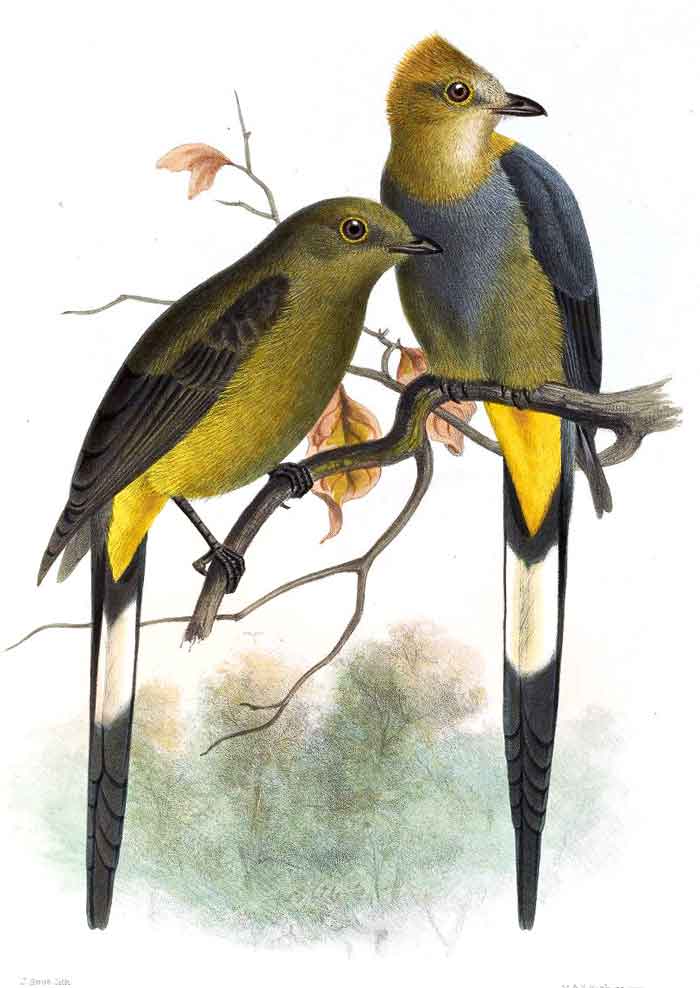
Ptiliogonys caudatus (*)
Superregnum: Eukaryota
Cladus: Unikonta
Cladus: Opisthokonta
Cladus: Holozoa
Regnum: Animalia
Subregnum: Eumetazoa
Cladus: Bilateria
Cladus: Nephrozoa
Superphylum: Deuterostomia
Phylum: Chordata
Subphylum: Vertebrata
Infraphylum: Gnathostomata
Megaclassis: Osteichthyes
Cladus: Sarcopterygii
Cladus: Rhipidistia
Cladus: Tetrapodomorpha
Cladus: Eotetrapodiformes
Cladus: Elpistostegalia
Superclassis: Tetrapoda
Cladus: Reptiliomorpha
Cladus: Amniota
Classis: Reptilia
Cladus: Eureptilia
Cladus: Romeriida
Subclassis: Diapsida
Cladus: Sauria
Infraclassis: Archosauromorpha
Cladus: Crurotarsi
Divisio: Archosauria
Cladus: Avemetatarsalia
Cladus: Ornithodira
Subtaxon: Dinosauromorpha
Cladus: Dinosauriformes
Cladus: Dracohors
Cladus: Dinosauria
Cladus: Saurischia
Cladus: Eusaurischia
Subordo: Theropoda
Cladus: Neotheropoda
Cladus: Averostra
Cladus: Tetanurae
Cladus: Avetheropoda
Cladus: Coelurosauria
Cladus: Tyrannoraptora
Cladus: Maniraptoromorpha
Cladus: Maniraptoriformes
Cladus: Maniraptora
Cladus: Pennaraptora
Cladus: Paraves
Cladus: Eumaniraptora
Cladus: Avialae
Infraclassis: Aves
Cladus: Avebrevicauda
Cladus: Pygostylia
Cladus: Ornithothoraces
Cladus: Ornithuromorpha
Cladus: Carinatae
Parvclassis: Neornithes
Cohors: Neognathae
Cladus: Neoaves
Cladus: Telluraves
Cladus: Australaves
Ordo: Passeriformes
Subordo: Passeri
Infraordo: Passerida
Superfamilia: Muscicapoidea
Familia: Ptiliogonatidae
Genus: Ptiliogonys
Species: Ptiliogonys caudatus
Name
Ptiliogonys caudatus Cabanis, 1861
Synonyms
Ptilogonys caudatus (protonym)
References
Cabanis, J. 1860. Uebersicht der im Berliner Museum befindlichen Vögel von Costa Rica. Journal für Ornithologie 8(48): 401–416 DOI: 10.1007/bf02002737 BHLReference page. Original description p. 402 BHL
Vernacular names

The long-tailed silky-flycatcher (Ptiliogonys caudatus) is a passerine bird that occurs only in the mountains of Costa Rica and western Panama, usually from 1,850 m altitude to the timberline. It is a thrush-sized species, weighing about 37 g. The silky-flycatchers are related to waxwings, and like that group, they have soft silky plumage.
The habitat of this bird is mountain forests, where the breeding pair builds a neat cup of lichen 2 to 18 m above ground in a tree, sometimes in loose colonies. The female lays two brown-and-lilac-blotched grey eggs, which are incubated by both adults. The young fledge 18 to 25 days after hatching and are fed by both parents.
The male long-tailed silky-flycatcher is 24 cm long and has a pale grey forehead. The rest of the crested head, neck, throat, and lower belly are yellow. The back, lower breast, and upper belly are blue-grey, and the flight feathers and long pointed tail are black. The outer tail feathers are spotted with white.
The female is 21 cm long and generally duller than the male, with a darker grey forehead, olive body plumage, and a shorter, duller black tail. Immatures are similar to adults, but the central tail feathers are shorter and the white spotting on the outer tail is indistinct.
This species forages in small flocks when not breeding, fly-catching for insects, or taking small fruits, especially mistletoe. Long-tailed silky-flycatchers often perch prominently on high, exposed twigs.
The call of the long-tailed silky-flycatcher is a repeated chee-chip.
This species is a host to the biting louse, Brueelia ptilogonis.
References
BirdLife International (2016). "Ptiliogonys caudatus". IUCN Red List of Threatened Species. 2016: e.T22708136A94150513. doi:10.2305/IUCN.UK.2016-3.RLTS.T22708136A94150513.en. Retrieved 12 November 2021.
Stiles and Skutch, A Guide to the Birds of Costa Rica ISBN 0-8014-9600-4
Retrieved from "http://en.wikipedia.org/"
All text is available under the terms of the GNU Free Documentation License

